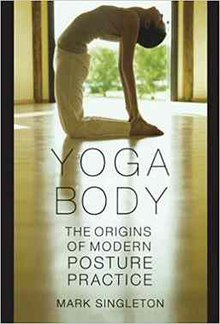 On the book's cover, a young woman performs Ustrasana, camel pose | |
| Author | Mark Singleton |
|---|---|
| Subject | History of modern yoga |
| Publisher | Oxford University Press |
Publication date | 2010 |
| Pages | 262 |
| OCLC | 318191988 |
Yoga Body: The Origins of Modern Posture Practice is a 2010 book on yoga as exercise by the yoga scholar Mark Singleton. It is based on his PhD thesis, and argues that the yoga known worldwide is, in large part, a radical break from hatha yoga tradition, with different goals, and an unprecedented emphasis on asanas, many of them acquired in the 20th century. By the 19th century, the book explains, asanas and their ascetic practitioners were despised, and the yoga that Vivekananda brought to the West in the 1890s was asana-free. Yet, from the 1920s, an asana-based yoga emerged, with an emphasis on its health benefits, and flowing sequences (vinyasas) adapted from the gymnastics of the physical culture movement. This was encouraged by Indian nationalism, with the desire to present an image of health and strength.
The book attracted wide interest, both among scholars and among yoga teachers and practitioners. Its argument has largely been accepted by scholars, and it has encouraged further research into the nature of modern yoga and its origins.
The book was attacked from two sides: saffronising Hindu nationalists wanting to reclaim yoga as a single thing, distinctively Indian; and modern global yoga marketing wanting to wrap its product "in the mantle of antiquity"[1] to maximise sales.